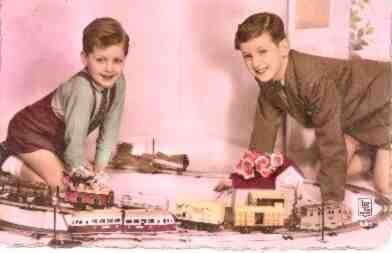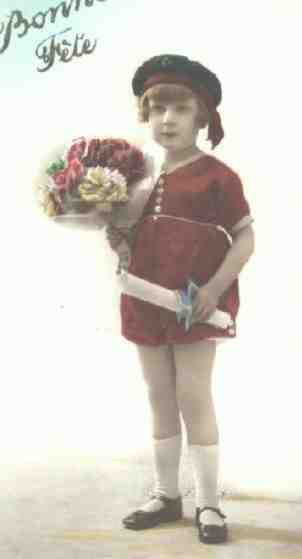
Figure 1.--This looks to be a photograph of French boys in the late 1920s or 1930s playing with model railroads. Note how formally thy are dressed. The younger boy wears suspender shorts.


Figure 1.--This looks to be a photograph of French boys in the late 1920s or 1930s playing with model railroads. Note how formally thy are dressed. The younger boy wears suspender shorts. |
The inter-war years were a major turning point in boys fashions. The formal clothes of the Victorian an Edwardian were discarded for lighter, less cumbersome styles. Boys still wore suits more than is common today, but the trend toward confortable, casual clothing had begun.
French attitudes toward boyhhod in the interwar years were strongly affected by the War and this affected popular clothes for children. A reader tells me about a book on the French people written by a gentleman who spent most of his life in France in the diplomatic service has a whole chapter on French men and woman. He is in love with French woman but has a very low opinion of French men, saying that they are a spoiled lot because of their upbringing. "I learned long ago not to have committed the faux pas of remarking to the mother of a young child wearing bloomers and long curled
hair: 'what a pretty little girl '". Often as not the child turns out to be a boy and the mother is insulted that you could possibly mistake her little boy for a girl. The contributor opines, "The diplomat may have been right about Frenchmen being spoiled. The generation he is talking about grew up between the world wars. A whole generation of French boys were wiped out in World War I. I can see why boys born after that War were cherished by their parent and grandparents." A French reader writes, "So after World War I ended, the French people wanted peace and enjoy life. The 1920s were called the " les folles années " ( the crasy years ). Women started a new way to see life. They wanted to be elegant and dressed with a youthful, sporty look. It is at this time that French mothers began to dress children with a kind of juvenile look. This convention continued through the 1960s. The French fashion was admired around the world, especially women's fashions. But French children's fashions were also influential."
French school boys in the inter-war period commobly wore berets and school smocks. Boys at private schools some times wore cloaks rather than coats. Boys commonly wore short panys. Sailor suits were still popular, but by the 1930s for increasingly younger boys. Rompers appeared in the 1920s and became incrasingly popular in the 1930s. After the mid-1930s some dressy styles of rompers appeared for formal occassions. Some suits came with knickers as well as short pants. The knickers were often reserved for winter weather. Older boys might also wear knicksers. Kneesocks were common during the winter and for dresswear.

Figure 2.--Younger French boys by the late 1920s and early 1930s began wearing shorter short pants, often with white kneesocks. |
HBC has noted fashion and clothing developments by decades during the inter-war period.
The boisterous roaring 1920s are referred to in France as "Les années folles". It was a period of enormous social change and no where was this as well illustrated as with clothing and hair styles. Little boys no longer commonly wore dresses. French mothers, howeber, did adapt a number of styles for such as modified Fautleroy suits with short shirts, white kneesocks, and strap shoes. These styles were mostly for little boys, but some older boys wore them for special occasions. Rompers became popular for younger boys, mostly as play garments. It is unknown to what extent such outfits were worn. Most of the photograhps I have seen come from modeled post cards, rather than actual family photographs. Sailor suits continued to be very popular. The major change in French boys clothes was in the trousers. Kneepants and long stockings were still worn in the early 1920s, but by the mid-1920s
boys were mostly wearing shortpants and kneesocks. Older boys might wear knickers. French boys in the 1920s were outfitted in the new short pants style. I'm not sure what the boys thoughtbof the new style. Certainly not having to wear long stockings in the summer must have been more comfortable.
French short pants by the l930s were generally worn shorter than in England, often well above the knees, and not as baggy. French boys, even older boys, commonly wore shorts during the 1920s, 1930s, and 1940s. Younger boys might wear short pants all year round,
including the winter--but with knee socks. Some mothers might buy long pants for winter wear. Most boys, however, primarilky wore shorts. Formal short pants suits were worn with knee socks, but ankle socks were often worn on more casual occasions and were more common than in England. Manybsuits came with both knickers and a pair of long pants. Boys of 19 might wear knickers until they were 21! Boys like men still commonly wore hats or caps during the 1920s-40s. The most common head gear for French boys were berets.
The early 1940s was dominated by World War II. Fashion took a back seat. France decalred war on Germany in September 1939. Germany invaded the Low Countries and then France itself in May 1940 and the French capitulated in June. In the armistace that folowed, southwestern France was not at first occupied abd was known as Vichy France. But the Germans occuped it also after the Anglo-American invasion of French North Africa in October 1942. France remained occupied until the Normandy invasion in June 1944 and the defeat of the German Army in France in August 1944. HBC does not think fashions cahnged greatly during the occuoation, but we have little actual information at this time. A French reader reports that during the German occupation, fashions for children did not really change. The major problem during the War was shortages. The material needed to make clothes became sacrse and by 1944 was often not available at all. The material that was available was often quite expensive. The Germans never interfered with fashion. In fact German companies during the War copied some French fashions. Many magasines carried clothing patterns because often the only way for mothers to obtain new clothes was to sew the garments themselves.
Boys' fashions in France during the 1920s were begining to be more juvenile than in England . In fact this started at the end of World War I in 1918. Many old photos show boys with a touch of baby clothes. Interestingly, this juvenile style for boys became popular at the sme time that it was becoming less common for younger boys to wear dresses. This juvenile look lasted in France utill the early 1960s. Gradually esnctive juvenile styles declined in popularity and boys clothing began to more and more resemble adult styles as was the practice in the 18th century. The strongest period in France for this juvenile look for boys was from 1936 utill the early 1960s. This style was especially popular in the cities, but was worn Sunday in rural areas as well. Garments included rompers, short pants and even very short pants along with blouses with puffed sleeves and Peter Pan (col Claudine) rounded collars were the basic clothes. There were also smocks, but these were seen as more of a utilitarian than a dressy garment. This juvenile look was one element in what French readers have described as the "garçon modéle".
French boys in the 1920s were outfitted in the new short pants style. I'm not sure what the boys thoughtbof the new style. Certainly not ] having to wear long stockings in the summer must have been more comfortable. French short pants by the l930s were generally worn shorter than in England, often well above the knees, and not as baggy. French boys, even older boys, commonly wore shorts during the 1920s, 1930s, and 1940s. Younger boys might wear short pants all year round, including the winter--but with knee socks. Some mothers might buy long pants for winter wear. Most boys, however, mostly wore shorts.
HBC has compiled the following accounts providing information on clothing about families and individuals.
French family: 1880s-90s (The De Lesseps)
French family: 1890s-1900s (The Renoirs)
French family: 1890s-1900s (Paul)
French family: 1890s-1900s (The Zolas)
French boy: 1900s (Jean Daubeville)
Alsatian boy: 1930s-40s (Tomi)
French boy and smocks: 1950s-60s
French boyhood: 1960s
American boy in France: 1960s
American boy at French school: 1960s
Navigate the Boys' Historical Clothing Web Site:
[Introduction]
[Activities]
[Biographies]
[Chronology]
[Clothing styles]
[Countries]
[Bibliographies]
[Contributions]
[French glossary]
[Satellite sites]
[Tools]
[Boys' Clothing Home]
Navigate the Boys' Historical Clothing French pages:
[Return to the Main French page]
[Return to the Main French chronology page]
[French choirs]
[French school uniforms]
[French school smocks]
[French royalty]
[French sailor suits]
[French scout uniforms]
[French postcards]
[French catalogs]
